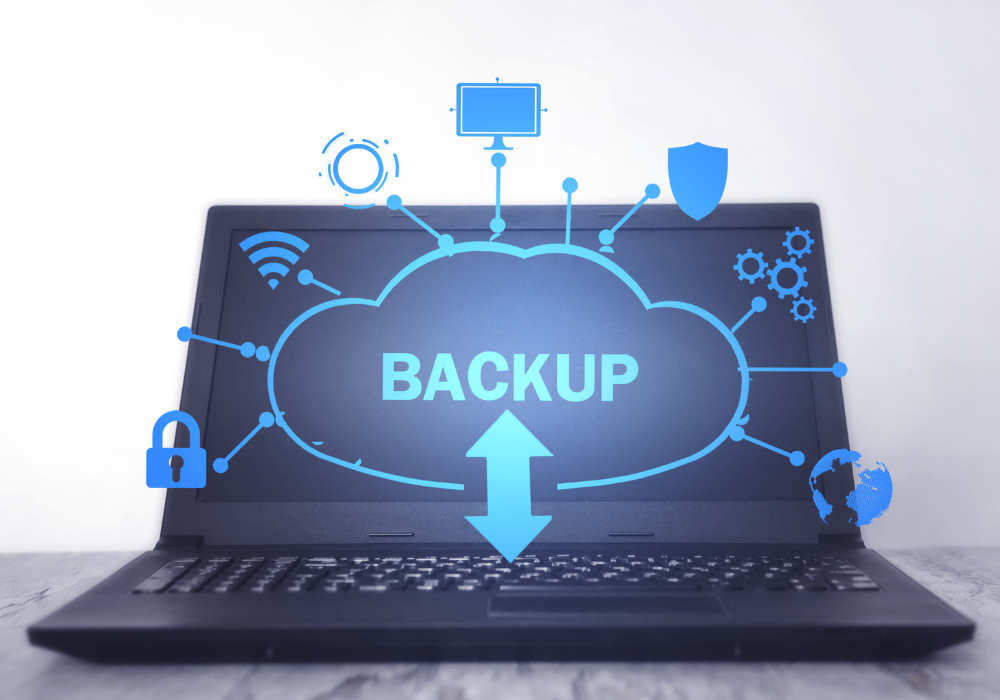Sunday, March 31st marked World Backup Day, an annual reminder of the importance of backing up data and prioritising data protection.
However, it's vital to remember that safeguarding our digital assets should be an ongoing concern. The risk of data loss looms large for modern businesses. From accidental deletions and hardware failures to cyber threats, numerous factors can jeopardise the integrity and availability of our digital assets.
In this blog post, we'll share expert tips and strategies to help you implement robust data backup and recovery practices. By following these guidelines, you can safeguard your digital assets, minimise the risk of data loss, and enjoy peace of mind knowing that your valuable information is securely backed up and readily recoverable when needed.
-
The Significance of Regular Backups
Our digital lives are constantly evolving, with new files, documents, and memories being created and stored every day. Relying on a single annual backup puts your data and sensitive information at risk.
Regular backups are key for safeguarding your digital assets against a wide range of threats. By keeping multiple, up-to-date copies of your data, you can minimise the risk of permanent data loss and ensure a smoother recovery process in the event of an incident.
Automating the Backup Process
To make data backup a seamless and consistent part of your routine, consider setting up automated backups. Modern backup solutions offer scheduling options that allow you to create automatic backups at predetermined intervals, such as daily, weekly, or monthly.
This approach eliminates the need for manual intervention and ensures that your data is consistently protected without the risk of forgetting or postponing backups.
By automating the backup process, you can rest assured that your critical files, documents, photos, and other digital assets are being securely copied and stored at regular intervals, providing you with multiple recovery points should the need arise.
-
Diversify Your Backup Solutions
While implementing regular backups is a critical step, it's equally important to diversify your backup solutions to ensure maximum data protection. Different backup methods offer varying levels of security, accessibility, and resilience against specific threats.
Leverage Multiple Backup Methods
For comprehensive data safeguarding, consider combining the following backup approaches:
- Cloud Backup: Cloud-based backup services provide an off-site storage solution, ensuring your data is safely stored in remote servers. This protects against local disasters like fires, floods, or theft.
- External Hard Drives: Portable external hard drives offer a convenient and cost-effective way to maintain local backups. They're ideal for quickly backing up large amounts of data.
- Network-Attached Storage (NAS): A NAS device acts as a dedicated backup solution, allowing you to store backups on a centralised, connected storage system within your local network.
By utilising a combination of these methods, you create multiple layers of protection against various data loss scenarios, reducing the risk of permanent data loss due to any single point of failure.
The 3-2-1 Backup Rule
Of all the data backup best practices, the 3-2-1 backup rule stands out as one of the most significant and widely recommended strategies. This rule serves as a reliable framework for ensuring comprehensive data protection and recovery capabilities, regardless of the specific circumstances that lead to data loss.
The 3-2-1 backup rule dictates the following:
- 3 total copies of your data (one primary copy and two backups)
- 2 of those copies are stored on different local devices or media (e.g., external hard drive and NAS)
- 1 copy stored off-site (e.g., cloud backup)
Following this guideline results in numerous redundancies that protect your data from a variety of potential dangers, such as software corruption, hardware malfunctions, cyberattacks, natural disasters, and even basic human error.
Having two local backups on different devices or media ensures that if one backup fails or becomes inaccessible, you still have another local copy available for recovery. This redundancy protects against scenarios like drive failures or accidental deletion.
The off-site backup, typically a cloud-based solution, serves as a critical safeguard against catastrophic events that could affect your local environment, such as fires, floods, or theft. With an off-site copy, you can access and restore your data from a remote location, minimising the risk of permanent data loss due to local disasters.
By following the 3-2-1 backup rule, you significantly increase the chances of successful data recovery, no matter what challenges or disruptions you may face.
This comprehensive approach to data protection provides peace of mind, knowing that your valuable digital assets are secure and recoverable, even in the face of the most adverse circumstances.
-
Test Your Recovery Plan
While diligently backing up your data is a crucial step, it's equally important to regularly test your recovery processes. Having backups is only half the battle; you also need to ensure that you can successfully restore your data when needed, without any hiccups or surprises.
Too often, individuals and businesses overlook the importance of testing their recovery plan until it's too late. Imagine facing a data loss emergency only to discover that your backups are incomplete, corrupted, or simply don't work as expected. Testing your recovery plan ahead of time can help identify and address potential issues before they become problems.
Conducting Effective Recovery Tests
To ensure that your backup and recovery strategy is robust and reliable, it's recommended to conduct periodic recovery tests. Here are some guidelines to help you test your recovery plan effectively:
- Choose a Test Environment: Restore your backups to a separate, non-production environment or a virtual machine to avoid disrupting your live systems.
- Test Different Scenarios: Simulate various data loss scenarios, such as hardware failures, ransomware attacks, or accidental deletions, to ensure your recovery plan can handle a wide range of situations.
- Verify Data Integrity: After restoring your backups, thoroughly check the restored data for completeness, consistency, and accuracy to ensure that no data was lost or corrupted during the recovery process.
- Test Critical Applications and Systems: If you have critical applications or systems that rely on your data, test their functionality and compatibility with the restored data to identify and resolve any potential issues.
- Document and Refine: Keep detailed records of your recovery tests, noting any challenges or issues encountered. Use this information to refine and improve your backup and recovery processes, ensuring they remain effective and up-to-date.
-
Stay Informed and Update Regularly
To ensure that your data remains protected, it's important to stay informed about the latest developments and update your backup and recovery strategies accordingly.
Keeping Up with Emerging Threats
Cybercriminals are continuously developing new tactics and techniques to compromise systems and steal or hold data for ransom. From sophisticated malware and ransomware attacks to zero-day exploits and social engineering schemes, the threat landscape is constantly shifting.
By staying informed about emerging threats and vulnerabilities, you can proactively adjust your data protection measures to address these new risks. Subscribe to security advisories, follow reputable cybersecurity news sources, and attend industry events or webinars to stay up-to-date with the latest trends and best practices.
Regular Software and Tool Updates
In addition to staying informed, it's essential to keep your backup software, tools, and systems updated with the latest security patches and feature enhancements. Software vendors regularly release updates to address newly discovered vulnerabilities, improve performance, and introduce new capabilities.
Failing to update your backup and recovery tools can leave your data exposed to known threats and potentially compromise your ability to recover in the event of an attack or data loss incident. Establish a routine for checking and applying updates to your backup solutions, ensuring that you're always running the latest, most secure versions.
-
Secure Your Backups
While having a robust backup strategy is essential, it's equally important to ensure that your backups themselves are secure and protected from unauthorised access or malicious attacks. Failing to secure your backups can render them useless in the event of a data breach or ransomware attack.
Encryption and Strong Passwords
One of the most effective ways to secure your backups is by employing strong encryption and password protection. Encryption scrambles your data, making it unreadable without the proper decryption key or password. This safeguards your backups from prying eyes, even if they fall into the wrong hands.
When using cloud backup services, ensure that your data is encrypted both in transit and at rest. Many reputable cloud providers offer built-in encryption options, but you can also use third-party encryption tools for an additional layer of security.
Additionally, use strong, unique passwords for your backup accounts and encryption keys. Avoid using easily guessable passwords or reusing the same password across multiple accounts, as this increases the risk of unauthorised access.
Protecting Against Ransomware
In recent years, ransomware attacks have become an increasingly prevalent threat, with cybercriminals holding data hostage and demanding payment for its release. In such scenarios, having secure backups can be a lifeline, allowing you to restore your data without giving in to the ransom demands.
However, ransomware can also target and encrypt your backup files, rendering them useless. To combat this threat, it's essential to implement measures that protect your backups from ransomware attacks, such as:
Storing backups on an air-gapped or disconnected system that cannot be accessed by ransomware.
Using immutable or write-once, read-many (WORM) storage solutions that prevent unauthorised modification or encryption of backups.
Regularly testing your ability to restore from backups to ensure they haven't been compromised.
By securing your backups with strong encryption, passwords, and ransomware protection measures, you can safeguard your valuable data from unauthorised access, malicious attacks, and even the most sophisticated cyber threats.
Conclusion
Effective data backup and recovery strategies are not just for World Backup Day - they're essential year-round practices. Throughout this blog, we've explored the significance of regular backups, diversifying solutions, testing recovery plans, staying informed on threats, and securing your backups.
While implementing these tips requires effort, the peace of mind of knowing your sensitive data is safeguarded against potential disasters is invaluable. Data loss can strike anytime, from hardware failures to cyber-attacks. Don't let yourself be caught unprepared.
If you need assistance implementing a robust data protection strategy, SpiderGroup is here to help. Our experts can design and maintain a tailored solution ensuring your data remains secure and recoverable.

.png)

